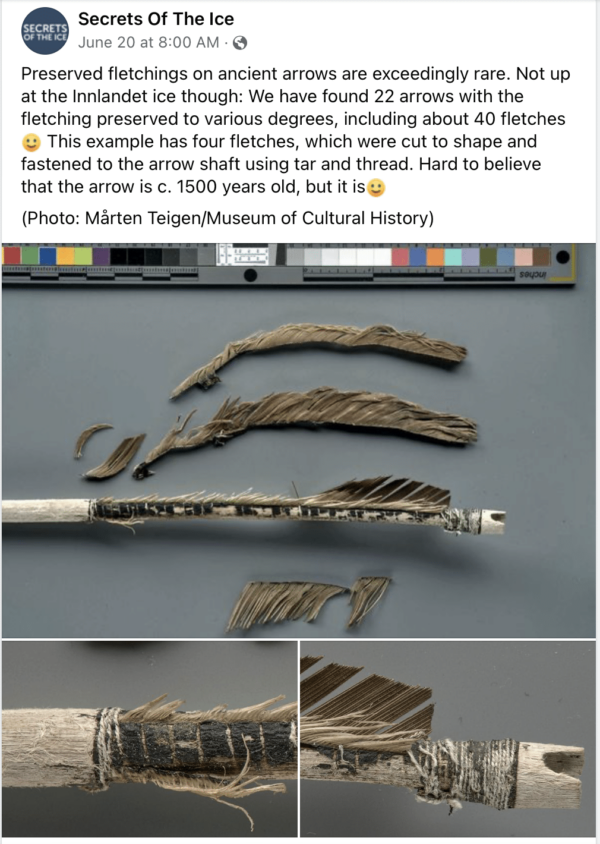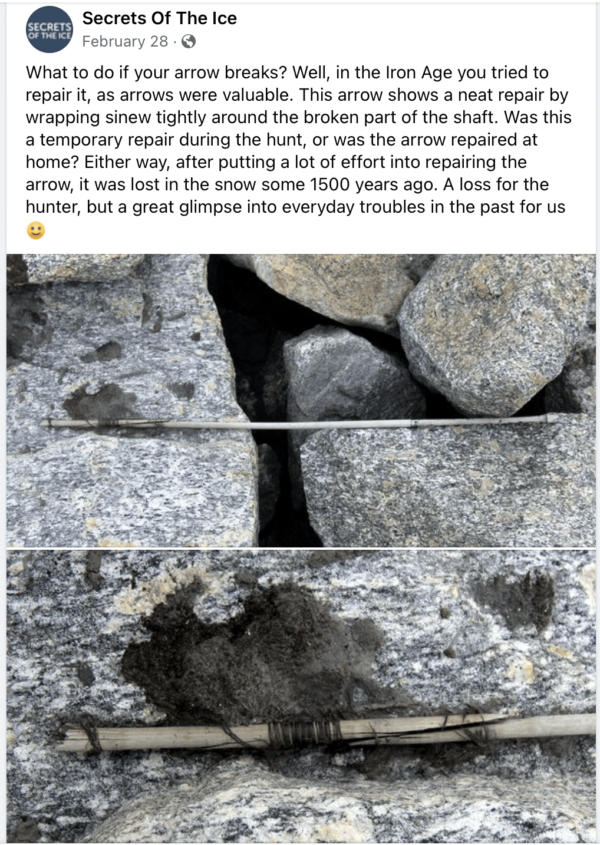What secrets lie within the glaciers of Norway? What archeological discoveries are uncovered when the icy tombs encasing these relics of ancient civilization begin to melt? Will we find that the items don’t seem so ancient after all? Secrets of the Ice, the official Facebook page for the Glacier Archaeology Program in Innlandet, Lillehammer, Norway, documents astonishing archeological finds that often include arrowheads, fletching and other items relating to archery. Their oldest finding in the region is 6,000 years old. Most of the relics date from thousands of years and countless generations before anyone living today was even a blip on the universal timeline. And yet, some of the artifacts they’re finding don’t look much different from what bowhunters who practice the traditional style use today.
One post on Secrets of the Ice mentions that hunters in Norway began using iron for their arrowheads around A.D. 300. Prior to that, they used stones and, most frequently, bone and antlers. Another post mentions that they have found three examples of arrowheads made of shells that can be dated back about 3,500 years. The arrowhead pictured above is made from reindeer antler. “The shape looks like the iron arrowheads that were introduced around AD 300, so we believe that our arrow is from around that date or slightly earlier. We found it near the melting ice at Trollsteinhøe in the Jotunheimen Mountains,” the post says. Traditional hunters can still make arrows out of antlers today. The process will likely look a little different now than it did then — it’s safe to assume they used stones and other objects to whittle down the antler, but those stones weren’t attached to a motor — but you can still use the same materials.

As we already knew, bowhunters have been using feather fetching for thousands of years. Photo credit: Secrets of the Ice / Marten Teigen / Museum of Cultural History
Archaeologists have found about 40 pieces of fletching in the Innlandet region, preserved to various degrees. The four fletches in the photo above were attached to the arrow shaft using tar and thread. “Hard to believe that the arrow is c. 1500 years old, but it is,” the post says. We’d have to wholeheartedly agree. Just look at the nocking point! This is another great example of how the fundamentals of arrows haven’t changed in thousands of years. Feather fletching, which was pretty much the only option for fletching for a long time, is still in wide use.
The arrow shafts found in these excavations are made of various woods, including birch, and as we know, wooden arrows are still popular today. A post on the page notes that the second-largest shaft they’ve found measures almost 40 inches, which is substantially longer than the usual 25 to 30 inches on modern arrows. The exceptionally large ones they’ve found are all at least 2,000 years old. The shorter shafts were seen going into the first millennium, so it is possible the shafts were shortened to accommodate the heaver iron arrowheads. The arrow shafts could afford to be longer when they were using light materials such as bones and shells. Either way, this is further confirmation that bowhunters have been using wood arrow shafts of a similar size for thousands of years.

Sinew can be used to bind arrowheads and fletching to the arrow shaft. Photo Credit: Secrets of the Ice
Today, fletching can be attached to the arrows with super glue, but when these artifacts originated, sinew was a popular binding agent for both the construction of the arrows and the repairs, as shown in the photo above. Sinew can still serve this purpose, which would make further use of your harvest in addition to wild game for your table. You take the tendons or backstrap of the animal, clean and dry it, pound it out, stretch it, and use it to bind your arrowhead and fletching to your arrow. You can review specific steps on Scout Life.
The amount of exciting archery and bowhunting-related content on the Secrets of the Ice site is staggering, and you could easily go down a wonderful rabbit hole looking at all the findings. Many of the arrowheads discovered in the region are longer than ones you’d see now, but it never ceases to amaze that the same materials — stone arrowhead, wood arrow shaft, feather fletching — have been used for eons. Keep that in mind the next time you go out into the woods with your traditional gear!